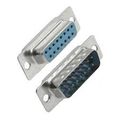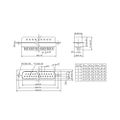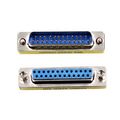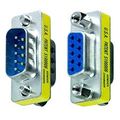D-sub connector: Difference between revisions
(Created page with "'''D-subminiature''' or '''D-sub''' connectors were introduced by Cannon in 1952. See [https://en.wikipedia.org/wiki/D-subminiature Wikipedia] for details. They were ubiquit...") |
No edit summary |
||
| (6 intermediate revisions by the same user not shown) | |||
| Line 1: | Line 1: | ||
'''D-subminiature''' or '''D-sub''' connectors were introduced by Cannon in 1952. | [[File:D-sub.png|thumb|300px|right]]'''D-subminiature''' or '''D-sub''' connectors were introduced by Cannon in 1952. | ||
See [https://en.wikipedia.org/wiki/D-subminiature Wikipedia] for details. | See [https://en.wikipedia.org/wiki/D-subminiature Wikipedia] for details. | ||
They were ubiquitous in computer applications from the 1960s to the early 21st century. | They were ubiquitous in computer applications from the 1960s to the early 21st century and are still in widespread use in industrial applications. Many data communication standards specify D-sub connectors, e.g | ||
[https://en.wikipedia.org/wiki/RS-232 V.24/RS-232] (DB-25 connector), [https://en.wikipedia.org/wiki/X.21 X.21] (DA-15 connector), etc. | |||
The D-sub series of connectors was introduced by [[wikipedia:Cannon (ITT Corporation)|Cannon]] in 1952. | |||
There are five basic shell sizes, DA through DE (see illustration). Cannon's part-numbering system used D as the prefix for the whole series, followed by one of A, B, C, D, or E denoting the shell size, followed by the number of pins or sockets, followed by either P (plug or pins) or S (socket) denoting the gender of the part. Each shell size usually (see below for exceptions) corresponds to a certain number of pins or sockets: A with 15, B with 25, C with 37, D with 50, and E with 9. For example, DB-25 denotes a D-sub with a 25-position shell size and a 25-position contact configuration. | |||
However, this naming pattern is not always followed. Because personal computers first used DB-25 connectors for their [[wikipedia:Serial port|serial]] and [[wikipedia:Parallel port|parallel]] ports, when the PC serial port began to use 9-pin connectors, they were often labeled as DB-9 instead of DE-9 connectors, due to an ignorance of the fact that B represented a shell size. It is now common to see DE-9 connectors sold as "DB-9 connectors". DB-9 nearly always refers to a 9-pin connector with an E size shell. | |||
Originally, all versions except DD had two rows of contacts. Later, "high density" versions with extra rows were added, the most widely used of which is the familiar DE-15 VGA connector. | |||
Special versions of D-shell connectors exist that replace some groups of contacts with coaxial or high-current inserts. | |||
Examples include the video signal connectors on 1990s Sun workstations, and the interface connectors on [[:Category:11800 series sampling plugins|Tektronix SD-series sampling heads]] (see photos). | |||
==Uses in Tektronix equipment== | ==Uses in Tektronix equipment== | ||
The DB9 connector can be found on Tektronix products like the . | |||
* DB-25 female in instruments having [[:Category:Parallel printer interface|parallel ("Centronics") printer ports]] | * DB-25 female in instruments having [[:Category:Parallel printer interface|parallel ("Centronics") printer ports]]; [[2792]], [[2794]], [[2795]]; [[2797]]; | ||
* DE-9 male (on older instruments, DB-25 male) on many instruments having [[:Category:RS-232 interface|RS-232 serial interfaces]] | * DE-9 male (on older instruments, DB-25 male) on many instruments having [[:Category:RS-232 interface|RS-232 serial interfaces]]; [[2782]], [[2784]]; | ||
* | * DA-15 on some instruments for accessory connections, e.g. [[2715]] | ||
* DD-50 on [[DF1]] (m) / [[7D01]] (f) | * DD-50 on [[DF1]] (m) / [[7D01]] (f) | ||
* DD-50 with four coaxial inserts in [[:Category:11800 series sampling plugins|11800 series sampling plugins]] | |||
* DE-15 female on newer instruments with VGA video output, such as the [[2402]], [[3026]], [[AM700]], [[TDS524]], [[TDS644]], [[TDS3012]], [[TDS3014]], [[TDS3032]], [[TDS3034]], [[TDS3052]], [[TDS3054]], [[TDS5032]], [[TDS5034]], [[TDS5054]], [[TDS5104]], [[RSA3303]], [[RSA3308]], [[RSA3408]], [[RSA5103]], [[RSA5106]], [[RSA5115]], [[RSA5126]], [[RSA6106]], [[RSA6114]], and [[RSA6120]] | |||
* ... | * ... | ||
| Line 16: | Line 30: | ||
<gallery> | <gallery> | ||
TDS644A back.jpg | DB-25, DE-9 and DE-15 connectors on the back of a [[TDS644A]] | |||
11800-connector-m.jpg | [[11801|11800 series]] (SD-xx) sampling head interface connector | |||
11800-connector-f.jpg | |||
</gallery> | |||
'''DB-15''' | |||
<gallery> | |||
DB15_Male_Female.jpg | "Male" and "Female" DB15 Connectors | |||
D-Sub_Mechanical Drawing.jpg | Mechanical drawing | |||
</gallery> | |||
'''DB-25''' | |||
<gallery> | |||
DB25_Male_Female.jpg | "Male" and "Female" DB25 Connectors | |||
D-Sub_Mechanical Drawing.jpg | Mechanical drawing | |||
</gallery> | |||
'''DC-37''' | |||
'''DE-9''' | |||
<gallery> | |||
DB9_Male_Female.jpg | "Male" and "Female" DB9 Connectors | |||
D-Sub_Mechanical Drawing.jpg | Mechanical drawing | |||
</gallery> | |||
'''DE-15''' | |||
<gallery> | |||
Male_VGA_connector.jpg | "Male" VGA plug | |||
Female_VGA_connector.jpg | "Female" VGA socket | |||
Male VGA mechnical drawing.jpg | "Male" Mechanical drawing | |||
Female VGA mechnical drawing.jpg | "Female" Mechanical drawing | |||
</gallery> | </gallery> | ||
[[Category:Low-voltage connectors]] | [[Category:Low-voltage connectors]] | ||
Latest revision as of 08:33, 8 October 2023

D-subminiature or D-sub connectors were introduced by Cannon in 1952.
See Wikipedia for details.
They were ubiquitous in computer applications from the 1960s to the early 21st century and are still in widespread use in industrial applications. Many data communication standards specify D-sub connectors, e.g V.24/RS-232 (DB-25 connector), X.21 (DA-15 connector), etc.
The D-sub series of connectors was introduced by Cannon in 1952. There are five basic shell sizes, DA through DE (see illustration). Cannon's part-numbering system used D as the prefix for the whole series, followed by one of A, B, C, D, or E denoting the shell size, followed by the number of pins or sockets, followed by either P (plug or pins) or S (socket) denoting the gender of the part. Each shell size usually (see below for exceptions) corresponds to a certain number of pins or sockets: A with 15, B with 25, C with 37, D with 50, and E with 9. For example, DB-25 denotes a D-sub with a 25-position shell size and a 25-position contact configuration.
However, this naming pattern is not always followed. Because personal computers first used DB-25 connectors for their serial and parallel ports, when the PC serial port began to use 9-pin connectors, they were often labeled as DB-9 instead of DE-9 connectors, due to an ignorance of the fact that B represented a shell size. It is now common to see DE-9 connectors sold as "DB-9 connectors". DB-9 nearly always refers to a 9-pin connector with an E size shell.
Originally, all versions except DD had two rows of contacts. Later, "high density" versions with extra rows were added, the most widely used of which is the familiar DE-15 VGA connector.
Special versions of D-shell connectors exist that replace some groups of contacts with coaxial or high-current inserts. Examples include the video signal connectors on 1990s Sun workstations, and the interface connectors on Tektronix SD-series sampling heads (see photos).
Uses in Tektronix equipment
The DB9 connector can be found on Tektronix products like the .
- DB-25 female in instruments having parallel ("Centronics") printer ports; 2792, 2794, 2795; 2797;
- DE-9 male (on older instruments, DB-25 male) on many instruments having RS-232 serial interfaces; 2782, 2784;
- DA-15 on some instruments for accessory connections, e.g. 2715
- DD-50 on DF1 (m) / 7D01 (f)
- DD-50 with four coaxial inserts in 11800 series sampling plugins
- DE-15 female on newer instruments with VGA video output, such as the 2402, 3026, AM700, TDS524, TDS644, TDS3012, TDS3014, TDS3032, TDS3034, TDS3052, TDS3054, TDS5032, TDS5034, TDS5054, TDS5104, RSA3303, RSA3308, RSA3408, RSA5103, RSA5106, RSA5115, RSA5126, RSA6106, RSA6114, and RSA6120
- ...
Pictures
-
DB-25, DE-9 and DE-15 connectors on the back of a TDS644A
-
11800 series (SD-xx) sampling head interface connector
-
DB-15
-
"Male" and "Female" DB15 Connectors
-
Mechanical drawing
DB-25
-
"Male" and "Female" DB25 Connectors
-
Mechanical drawing
DC-37
DE-9
-
"Male" and "Female" DB9 Connectors
-
Mechanical drawing
DE-15
-
"Male" VGA plug
-
"Female" VGA socket
-
"Male" Mechanical drawing
-
"Female" Mechanical drawing










